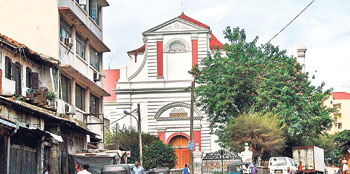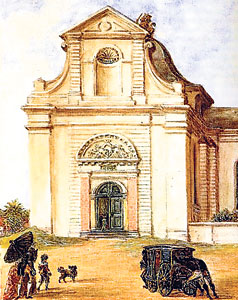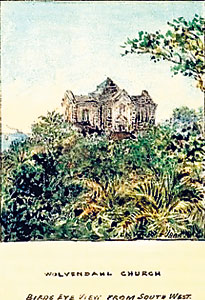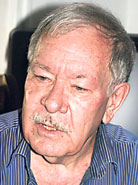It is the finest and only monument of the Dutch era left intact in modern Colombo, and eloquent of the peoples who designed and built it – a spot everyone even if they had no concern with religion – should visit. This church of many memories which has withstood the storms and vicissitudes of over two centuries serves to this day as bulwark which shuts out a work-a-day world and conjures by aid of tradition and the hoary memorials within its walls, evidence of those times when life moved leisurely in what was once the civic area of Colombo. - R.L. Brohier “Changing Face of Colombo”
It was well nigh 50 years ago, in 1962, that a young Merchant Marine officer, Christiaan van Krimpen first saw the Wolvendaal church in Pettah, when he sailed to Colombo on the Mississippi Lloyd. “I was astonished,” he remembers. Many years later in the early ’80s, van Krimpen visited again in his official capacity as Director of the Rotterdam port and admits to ducking some of his official duties to wander off and discover the churches and forts built by his Dutch countrymen in centuries past in their conquest of this island.
 |
| The Church then as painted by JLK Van Dort (inset) and now. Pictures courtesy www.wolvendaal.org |
The island has a very personal fascination for him, he admits, for one of his forefathers, a captain of the VOC (the Dutch East India Company) died in 1688 in Pettah and is buried here. Still looking for his tombstone, for van Krimpen, the international lawyer cum naval officer whose work has inclded the very weighty tasks of drafting laws for new ports, the island feels like home. “If I am here I sort of have the feeling I am home. If I sit in the Wolvendhaal church I feel yes, I’ve been here before,” he says.
These days, tombstones apart, his more urgent mission, which brings him quite frequently to Sri Lanka is the restoration of the Wolvendaal Church which mariners of yore saw rising like a beacon on the hill before it was shrouded by burgeoning high-rises. The church built in 1749 was considered the Mother Church by the Protestants, so much so an English Governor called it ‘the Westminster Abbey of Ceylon’.
Seated across the room, the country’s expert on all things Dutch, Deloraine Brohier traces her own connection to this historic church, this too an intensely personal one. “I have a pathfinder in my father,” she smiles and indeed the book she holds is proof enough of Brohier Senior’s dedication to the Church. An eminent scholar, historian and author of many books, Dr. R.L. Brohier’s ‘De Wolvendaalsche Kerk’ was first published in 1938 and reprinted in 1958 and 1982. Translated into Dutch by Maria Jurriaanse, an Assistant Archivist at the Department of Archives, it had black and white photographs of the church’s interior and exterior by Lionel Wendt done expressly at the author’s request.
Ever since her father passed away in 1980, it has been a cherished wish to have the book redone and Deloraine is more than gratified that in Christiaan van Krimpen she found someone who shared her enthusiasm for the project. He searched the Rijksmuseum and other archives in Amsterdam to procure old prints and material, revising the somewhat archaic Dutch text into a more modern form. Finally ready, ‘Time, Like An Ever-Rolling Stream’, the new book, edited and extended by Deloraine Brohier and Christiaan van Krimpen will be presented to the Dutch ambassador Leoni Cuelenare on Friday, November 12 at 4 p.m. in a simple ceremony at the church.
 |
 |
| The cover pic of the book: Wolvendaal as it was, surrounded by jungle |
The hard cover volume has its original contents enhanced by the addition of new material such as images of the paintings of J.L.K Van Dort. And van Krimpen was determined to find an elusive picture - of the man at whose behest the church was built – Julius Valentyn Stein von Gollanese, Dutch Governor of Ceylon from 1743-1751.
The book’s cover has a painting of the church surrounded by jungle and indeed, this is how it came by its name of Wolvendaal. “The area was jungle, it was a swamp, outside the Fort. There were jackals, and their howl was interpreted as the howl of wolves. Daal means valley and so it was the valley of the wolves,” says Deloraine, relating how in those days the worshippers would arrive by curricle or be brought in a palanquin, while others walked up the hill.
Yet, even if the surrounds are much changed from the days when the Governors made their stately way to church and its imposing presence overlooking the city is lost, the Wolvendaal church has much to commend it. It is one of the few churches built in the cruciform shape, rare even in the Netherlands. Its massive walls, five to six feet thick are still remarkably well preserved as are the heavy wooden doors and within the church a virtual gallery of Dutch artifacts from the Governors’ coat of arms on the walls greet the visitor. Poignantly worded tombstones are underfoot, some hinting of tragedy and sad early deaths. The huge windows had ‘heavily mullioned wooden frames’ but were subsequently replaced by stained glass. “There are about eight windows, many gifted to the church by a British Governor Sir William H. Gregory. When the British took over, they had no state church and the British Governor came to service and sat in the Governor’s pew,” says Deloraine. The Governor’s pew, the original wooden pulpit, the pipe organ (dating to British times) all remain. The vaults in the southern wing of the church which hold the tombs of the VIPs have not been opened for centuries.
Offering more insights she explains that there is no altar in the church, in true Calvinist tradition. That was because the whole concept of Calvin was to build up the congregation - it’s the congregation that runs the church. The ministers have no hierarchy, they are predikants (preachers). Communion is taken with all seated around a table as in the time of Christ.
This is the very unique legacy that the Wolvendaal Foundation set up in 2005, is seeking to preserve. Made up not specifically of church members it allows those interested in the church and heritage…historians, architects and others to help in its restoration.
The excellent and exhaustive website www.wolvendaal.org that van Krimpen has meticulously put together provides all the information: “The Wolvendaal Foundation has been established in 2005 by the Dutch Reformed Church of Sri Lanka. Its main aim is the renovation and maintenance of historic churches and buildings under the management of the church. The churches and monuments comprise the Wolvendaal Church in Pettah, the Groote Church in Galle fort, the DRC church in the fort of Matara, the Kalpitya church and the Cayman’s Gate bell tower in Pettah. Another part of its mission is the conservation and preservation of the ancient documents, books, and publications in the possession of the Wolvendaal Local Consistory and other Consistories of the Dutch Reformed Church”.
 |
 |
| Deloraine Brohier |
Christiaan van Krimpen |
It was considered a matter of great urgency that all the old marriage and baptism registers dating back a few centuries that had been stored away in cupboards in the church vestry be restored; the passage of years had seen them crumbling to the touch. “Most of the church archives have been produced in the Dutch Era of Ceylon (1642 – 1795). They specifically deal with the history of the Dutch Reformed Church (currently Christian Reformed Church), the Dutch East India Company (VOC) in Ceylon, the local adherents of the Dutch Reformed Church and the Dutch Burgher community, from the beginning of 1700 until today.” Just two months ago, the Foundation was pleased to see restoration work officially launched with a team headed by a former senior conservator from the Department of National Archives of Colombo, with financial assistance from the Dutch Embassy. There are some 37,000 pages to be gone through and the project will, it is estimated, take some three years to complete, after which the documents will be available to the public on the internet.
There’s more to be done. “The church roof is falling down,” says van Krimpen bluntly. Originally topped by a weathercock which was unseated by a bolt of lightning, the roof made of brick-barrel arches was replaced by timber covered with blue Bangor slates, then corrugated iron. “It is leaking in many places and if that goes on the whole support structure will collapse. We have approached the Dutch Embassy. We need to repair the existing roof, probably waterproof it for the moment.”
Making a fervent appeal for public support, he says, “The church does not have the financial means to do all this which is why the foundation is there. You have to paint the church every three to five years and even that costs so much.” It is his and Deloraine’s wish that the book will not only afford visitors a glimpse of the church’s past glory but also be an inspiration to help in its preservation.
This is a monument, it is part of Sri Lankan history, it is part of Dutch history, adds van Krimpen, perhaps unconsciously echoing Dr. R.L. Brohier’s words: “None who enter this church of hallowed memories and strange echoes will deny that there is something about it, that sets the mind a-thinking of those days and other men.” |
